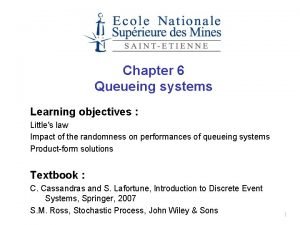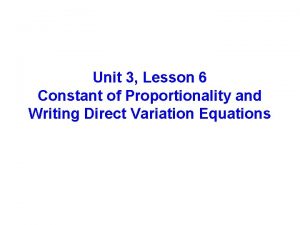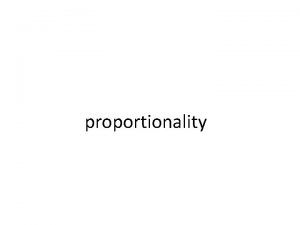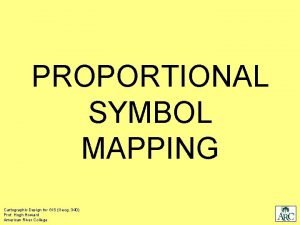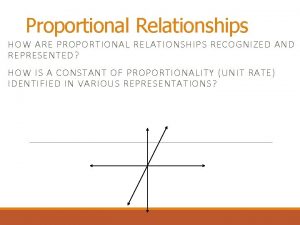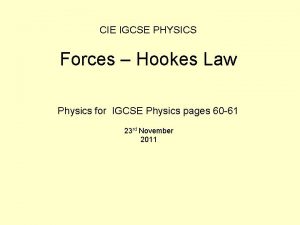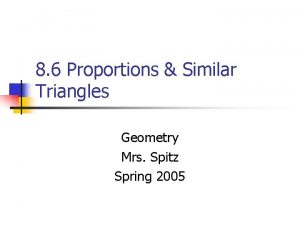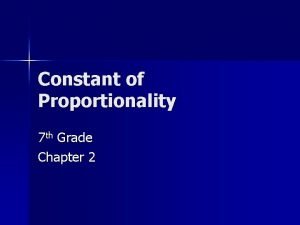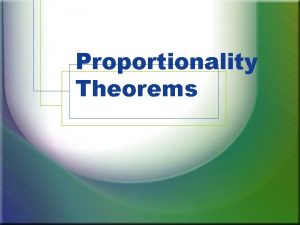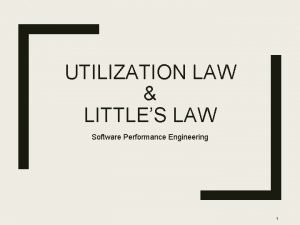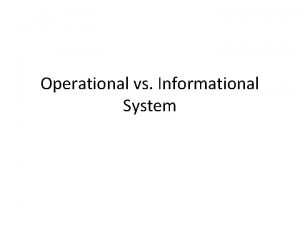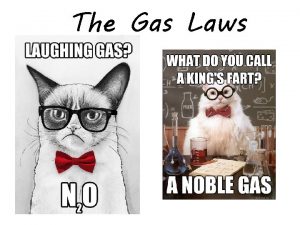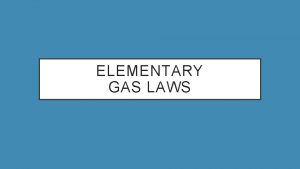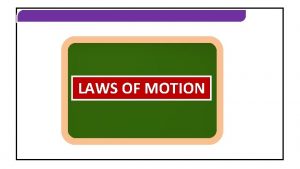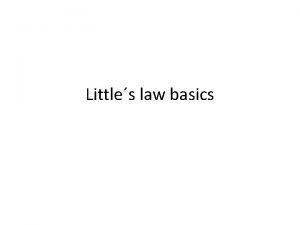Littles Law Operational Laws Littles Law Proportionality relation

![Little’s Law • Proportionality relation between the average number of jobs (E[N]) in a Little’s Law • Proportionality relation between the average number of jobs (E[N]) in a](https://slidetodoc.com/presentation_image_h/1e75f2f11f82b68e0143e047fc25a8f9/image-2.jpg)




![Summary • Open systems – E[N] = λ E[T] (Little’s Law) – E[Nsubsystem] = Summary • Open systems – E[N] = λ E[T] (Little’s Law) – E[Nsubsystem] =](https://slidetodoc.com/presentation_image_h/1e75f2f11f82b68e0143e047fc25a8f9/image-7.jpg)

![Example (1) … N = 10, E[Z] =5 • System A: DCPU = 4. Example (1) … N = 10, E[Z] =5 • System A: DCPU = 4.](https://slidetodoc.com/presentation_image_h/1e75f2f11f82b68e0143e047fc25a8f9/image-9.jpg)
![• Example (2) Summary – – – N = X E[T] = X • Example (2) Summary – – – N = X E[T] = X](https://slidetodoc.com/presentation_image_h/1e75f2f11f82b68e0143e047fc25a8f9/image-10.jpg)
![• Example (2) Original system Summary – – – N = X E[T] • Example (2) Original system Summary – – – N = X E[T]](https://slidetodoc.com/presentation_image_h/1e75f2f11f82b68e0143e047fc25a8f9/image-11.jpg)




- Slides: 15

Little’s Law & Operational Laws
![Littles Law Proportionality relation between the average number of jobs EN in a Little’s Law • Proportionality relation between the average number of jobs (E[N]) in a](https://slidetodoc.com/presentation_image_h/1e75f2f11f82b68e0143e047fc25a8f9/image-2.jpg)
Little’s Law • Proportionality relation between the average number of jobs (E[N]) in a system and the average system time (E[T]) of those jobs (the job arrival rate is the proportionality constant) – No assumptions about the arrival or service processes • Two similar versions: Open and closed systems • Little’s Law for an ergodic open system: E[N] = λ E[T] – λ is the average job arrival rate in the system • Little’s law for an ergodic closed system: N = X E[T] – N is constant and equal to the multi-programming level – X is the system throughput (rate of job completion) – E[T] = E[R] + E[Z], where R is response time, and Z think time – Alternative version (Response Time Law): E[R] = N/X – E[Z] 2

Applying Little’s Law – (1) 1 2 • Assume that the above system is ergodic with X = = 1+ 2 , where 1 ( 2) is he arrival rate of red (green) jobs – Ergodicity requires < • Utilization Law: system = server – Let ( i) be fraction of time server is busy (with type i jobs) – Note: This is also the average number of (type i) jobs in service – Little’s Law implies = / ( i = i/ ), or = E[S] • Note: If E[S 1] E[S 2], then i = i/ i, where i = E[Si] • Time in queue: system = queue – E[NQi] = i E[TQi] 3

Applying Little’s Law – (2) … N in out • Assume N = 10, E[Z] = 5 secs, and E[R] = 15 secs • What is the system throughput X? N = X E[T] = X(E[Z] + E[R]) X = N/(E[R] + E[Z]) = 10/(5+15) = 0. 5 jobs/sec 4

Forced Flow Law • Relates system throughput to throughput of individual device – X is system throughput, Xi is throughput of device i – Vi is average number of visit to device i per job • Forced Flow Law: Xi = E[Vi] X – Basically accounts for the fact that for every system completion, there must have been E[Vi] completions (visits) at device i, so the rate of completion at device i must be higher in that same proportion 5

Bottleneck Law • Di is the per job service demand at device i, i. e. , total demand across all visits to device i – Di = Si, 1 + Si, 2 + … + Si, Vi – This implies E[Di] = E[Vi] E[Si], if Vi and Si are independent (a typical scenario) – Note that E[Di] = Bi/C, where Bi is the busy time at device i and C is the number of service completion during that time period • Bottleneck Law: i = X E[Di] ( i = Xi E[Si] = X E[Vi] E[Si] = X E[Di]) – Rate of outside arrivals is X and each such arrival contributes E[Di] worth of service time at device i, so that device i is busy a fraction of time ( i) equal to X E[Di] 6
![Summary Open systems EN λ ET Littles Law ENsubsystem Summary • Open systems – E[N] = λ E[T] (Little’s Law) – E[Nsubsystem] =](https://slidetodoc.com/presentation_image_h/1e75f2f11f82b68e0143e047fc25a8f9/image-7.jpg)
Summary • Open systems – E[N] = λ E[T] (Little’s Law) – E[Nsubsystem] = subsytem E[Tsubsystem] (Little’s Law) • Closed systems – N = X E[T] = X (E[R] + E[Z]) (Little’s Law) – E[R] = N/X – E[Z] (Response Time Law) – i = i/ i = i E[Si] = Xi E[Si] (Utilization Law) – Xi = E[Vi] X (Forced Flow Law) – i = X E[Di] (Bottleneck Law) 7

Building on Little’s Law • Bounds on throughput and response time for closed systems where Dmax = maxi{E[Di]} (system bottleneck) First expression holds for N small, while second expression holds for N large • N* as the N value for which the two expressions are equal, i. e. , N* = (D+E[Z])/Dmax – When N > N*, throughput is dominated by bottleneck component 8
![Example 1 N 10 EZ 5 System A DCPU 4 Example (1) … N = 10, E[Z] =5 • System A: DCPU = 4.](https://slidetodoc.com/presentation_image_h/1e75f2f11f82b68e0143e047fc25a8f9/image-9.jpg)
Example (1) … N = 10, E[Z] =5 • System A: DCPU = 4. 6 and Ddisk = 4. 0 • System B: DCPU = 4. 9 and Ddisk = 1. 9 CPU Disk • Which system has higher throughput? – First compute N* (N* = (D+E[Z])/Dmax) for both systems • DA = DCPU + Ddisk = 8. 6, DA, max = 4. 6 NA* = (8. 6+5)/4. 6 = 2. 95 • DB = DCPU + Ddisk = 6. 8, DB, max = 4. 9 NB* = (6. 8+5)/4. 9 = 2. 41 • NA* & NB* << N – So in both cases, the throughput is dominated by Dmax, and System A wins because it has a lower Dmax value 9
![Example 2 Summary N X ET X • Example (2) Summary – – – N = X E[T] = X](https://slidetodoc.com/presentation_image_h/1e75f2f11f82b68e0143e047fc25a8f9/image-10.jpg)
• Example (2) Summary – – – N = X E[T] = X (E[R] + E[Z]) E[R] = N/X – E[Z] (Response Time Law) i = i/ i = i E[Si] = Xi E[Si] (Utilization Law) Xi = E[Vi] X (Forced Flow Law) i = X E[Di] (Bottleneck Law) • Measurements for interactive system with N = 20 and E[Z] = 15 secs: – – – – T = 650 secs (duration of measurements) BCPU = 400 secs Bslowdisk = 100 secs Bfastdisk = 600 secs C = CCPU = 200 jobs Cslowdisk = 2, 000 jobs Cfastdisk = 20, 000 jobs • Improvements under consideration (are they worth it? ) a) b) c) d) Faster CPU Rebalancing disks Add a second fast disk, and split the load of the original fast disk using it (Note: This is sub-optimal – should rebalance across all three disks) Combine all three improvements, including rebalancing all three disks 10
![Example 2 Original system Summary N X ET • Example (2) Original system Summary – – – N = X E[T]](https://slidetodoc.com/presentation_image_h/1e75f2f11f82b68e0143e047fc25a8f9/image-11.jpg)
• Example (2) Original system Summary – – – N = X E[T] = X (E[R] + E[Z]) E[R] = N/X – E[Z] (Response Time Law) i = i/ i = i E[Si] = Xi E[Si] (Utilization Law) Xi = E[Vi] X (Forced Flow Law) i = X E[Di] (Bottleneck Law) • Measurements for interactive system with N = 20 and E[Z] = 15 secs: – T = 650 secs (duration of measurements) – BCPU = 400 secs, Bslowdisk = 100 secs, Bfastdisk = 600 secs – C = CCPU = 200 jobs. Cslowdisk = 2, 000 jobs, Cfastdisk = 20, 000 jobs • Intermediate quantities – – – – – E[DCPU] = BCPU/C = 400 secs/200 jobs = 2. 0 secs/job E[Dslowdisk] = Bslowdisk/C = 100 secs/200 jobs = 0. 5 secs/job E[Dfastdisk] = Bfastdisk/C = 600 secs/200 jobs = 3. 0 secs/job E[VCPU] = CCPU/C = 200 visits/200 jobs = 1. 0 visit/job E[Vslowdisk] = Cslowdisk/C = 2, 000 visits/200 jobs = 10 visits/job E[Vfastdisk] = Cfastdisk/C = 20, 000 visits/200 jobs = 100 visits/job E[SCPU] = BCPU/CCPU = 400 secs/200 visits = 2. 0 secs/visit E[Sslowdisk] = Bslowdisk/Cslowdisk = 100 secs/2, 000 visits = 0. 05 sec/visit E[Sfastdisk] = Bfastdisk/Cfastdisk = 600 secs/20, 000 visits =0. 03 sec/visit • Original system: Dmax= 3 secs/job, D = 5. 5 secs/job, N* = 20. 5/3 7 << N = 20 – So X 1/Dmax= 0. 33 jobs/sec and E[R] N Dmax – E[Z] = 45 secs 11

• Example (2 a) – Faster CPU Summary – – – N = X E[T] = X (E[R] + E[Z]) E[R] = N/X – E[Z] (Response Time Law) i = i/ i = i E[Si] = Xi E[Si] (Utilization Law) Xi = E[Vi] X (Forced Flow Law) i = X E[Di] (Bottleneck Law) • Metrics for interactive system with N = 20 and E[Z] = 15 secs: – – – – – E[DCPU] = BCPU/C = 400 secs/200 jobs = 2. 0 secs/job E[Dslowdisk] = Bslowdisk/C = 100 secs/200 jobs = 0. 5 secs/job E[Dfastdisk] = Bfastdisk/C = 600 secs/200 jobs = 3. 0 secs/job (bottleneck) E[VCPU] = CCPU/C = 200 visits/200 jobs = 1. 0 visit/job E[Vslowdisk] = Cslowdisk/C = 2, 000 visits/200 jobs = 10 visits/job E[Vfastdisk] = Cfastdisk/C = 20, 000 visits/200 jobs = 100 visits/job E[SCPU] = BCPU/CCPU = 400 secs/200 visits = 2. 0 secs/visit E[Sslowdisk] = Bslowdisk/Cslowdisk = 100 secs/2, 000 visits = 0. 05 sec/visit E[Sfastdisk] = Bfastdisk/Cfastdisk = 600 secs/20, 000 visits =0. 03 sec/visit • Faster CPU (twice as fast): E[DCPU] = 1. 0 sec/job, but Dmax remains unchanged and N* stays approximately constant – Hardly any improvement as the fast disk is the bottleneck 12

• Example (2 b) – Rebalance Disks • – – – N = X E[T] = X (E[R] + E[Z]) E[R] = N/X – E[Z] (Response Time Law) i = i/ i = i E[Si] = Xi E[Si] (Utilization Law) Xi = E[Vi] X (Forced Flow Law) i = X E[Di] (Bottleneck Law) Metrics for interactive system with N = 20 and E[Z] = 15 secs: – – – – – • Summary E[DCPU] = BCPU/C = 400 secs/200 jobs = 2. 0 secs/job E[Dslowdisk] = Bslowdisk/C = 100 secs/200 jobs = 0. 5 secs/job E[Dfastdisk] = Bfastdisk/C = 600 secs/200 jobs = 3. 0 secs/job E[VCPU] = CCPU/C = 200 visits/200 jobs = 1. 0 visit/job E[Vslowdisk] = Cslowdisk/C = 2, 000 visits/200 jobs = 10 visits/job E[Vfastdisk] = Cfastdisk/C = 20, 000 visits/200 jobs = 100 visits/job E[SCPU] = BCPU/CCPU = 400 secs/200 visits = 2. 0 secs/visit E[Sslowdisk] = Bslowdisk/Cslowdisk = 100 secs/2, 000 visits = 0. 05 sec/visit E[Sfastdisk] = Bfastdisk/Cfastdisk = 600 secs/20, 000 visits =0. 03 sec/visit Clearly, we have overloaded the fast disk. Optimal balancing is such that – E[Vslowdisk] E[Sslowdisk] = E[Vfastdisk] E[Sfastdisk] or E[Vslowdisk] 0. 05 = E[Vfastdisk] 0. 03 while keeping E[Vslowdisk] + E[Vfastdisk] = 110 – This gives E[Vfastdisk] 69 and E[Vslowdisk] 41 and consequently E[Dslowdisk] = E[Dfastdisk] = 2. 06 secs, and therefore a new value of Dmax = 2. 06 secs – D is now 6. 12 secs and N* becomes 10, which remains smaller than N. Hence, throughput and response time are still dominated by Dmax, and the system improves to X 0. 485 jobs/sec and E[R] = 26. 2 secs 13

• Example (2 c) – Add Another Fast Disk Summary – – – N = X E[T] = X (E[R] + E[Z]) E[R] = N/X – E[Z] (Response Time Law) i = i/ i = i E[Si] = Xi E[Si] (Utilization Law) Xi = E[Vi] X (Forced Flow Law) i = X E[Di] (Bottleneck Law) • Metrics for interactive system with N = 20 and E[Z] = 15 secs: – – – – – E[DCPU] = BCPU/C = 400 secs/200 jobs = 2. 0 secs/job E[Dslowdisk] = Bslowdisk/C = 100 secs/200 jobs = 0. 5 secs/job E[Dfastdisk] = Bfastdisk/C = 600 secs/200 jobs = 3. 0 secs/job E[VCPU] = CCPU/C = 200 visits/200 jobs = 1. 0 visit/job E[Vslowdisk] = Cslowdisk/C = 2, 000 visits/200 jobs = 10 visits/job E[Vfastdisk] = Cfastdisk/C = 20, 000 visits/200 jobs = 100 visits/job E[SCPU] = BCPU/CCPU = 400 secs/200 visits = 2. 0 secs/visit E[Sslowdisk] = Bslowdisk/Cslowdisk = 100 secs/2, 000 visits = 0. 05 sec/visit E[Sfastdisk] = Bfastdisk/Cfastdisk = 600 secs/20, 000 visits =0. 03 sec/visit • If we split the fast disk load across two fast disks, we get – E[Dfastdisk 1] = E[Dfastdisk 2] = 1. 5 jobs/sec – The slow disk becomes the bottleneck which yieds a new value of Dmax = 2. 0 secs – D does not change but since Dmax does, N* = (D+E[Z])/Dmax 10. Still smaller than N, so that the system improves to X = 0. 5 jobs/sec and E[R] = 25 secs 14

• Example (2 d) – Combine All Improvements • – – – N = X E[T] = X (E[R] + E[Z]) E[R] = N/X – E[Z] (Response Time Law) i = i/ i = i E[Si] = Xi E[Si] (Utilization Law) Xi = E[Vi] X (Forced Flow Law) i = X E[Di] (Bottleneck Law) Metrics for interactive system with N = 20 and E[Z] = 15 secs: – – – – – • Summary E[DCPU] = BCPU/C = 400 secs/200 jobs = 2. 0 secs/job E[Dslowdisk] = Bslowdisk/C = 100 secs/200 jobs = 0. 5 secs/job E[Dfastdisk] = Bfastdisk/C = 600 secs/200 jobs = 3. 0 secs/job E[VCPU] = CCPU/C = 200 visits/200 jobs = 1. 0 visit/job E[Vslowdisk] = Cslowdisk/C = 2, 000 visits/200 jobs = 10 visits/job E[Vfastdisk] = Cfastdisk/C = 20, 000 visits/200 jobs = 100 visits/job E[SCPU] = BCPU/CCPU = 400 secs/200 visits = 2. 0 secs/visit E[Sslowdisk] = Bslowdisk/Cslowdisk = 100 secs/2, 000 visits = 0. 05 sec/visit E[Sfastdisk] = Bfastdisk/Cfastdisk = 600 secs/20, 000 visits =0. 03 sec/visit With faster CPU and two fast disks and rebalancing load across three disks, we get – E[DCPU] = 1 sec/job, E[Dfastdisk 1] = E[Dfastdisk 2] = E[Dslowdisk] = 1. 27 jobs/sec D = 4. 8 secs • Where we have used E[Vslowdisk] 0. 05 = E[Vfastdisk] 0. 03, and E[Vslowdisk] + 2 E[Vfastdisk] = 110 – This gives Dmax = 1. 27 secs and N* = (D+E[Z])/Dmax 16 that remains smaller than N – Hence, throughput and response time are still dominated by Dmax, and the system improves to X 0. 787 jobs/sec and E[R] = 10. 4 secs 15
 Littles law
Littles law Little's formula queueing theory
Little's formula queueing theory Charles de secondat
Charles de secondat Constant of proportionality guided notes
Constant of proportionality guided notes Proportionality constant
Proportionality constant Proportional symbol map definition
Proportional symbol map definition A proportional relationship
A proportional relationship Triangle proportionality theorem
Triangle proportionality theorem What makes a graph proportional
What makes a graph proportional What is the constant of proportionality
What is the constant of proportionality Whats the constant of proportionality
Whats the constant of proportionality State hooke's law
State hooke's law Proportion of triangles
Proportion of triangles Triangle proportionality theorem worksheet
Triangle proportionality theorem worksheet Two transversal proportionality corollary
Two transversal proportionality corollary How to find the constant of proportionality on a graph
How to find the constant of proportionality on a graph

